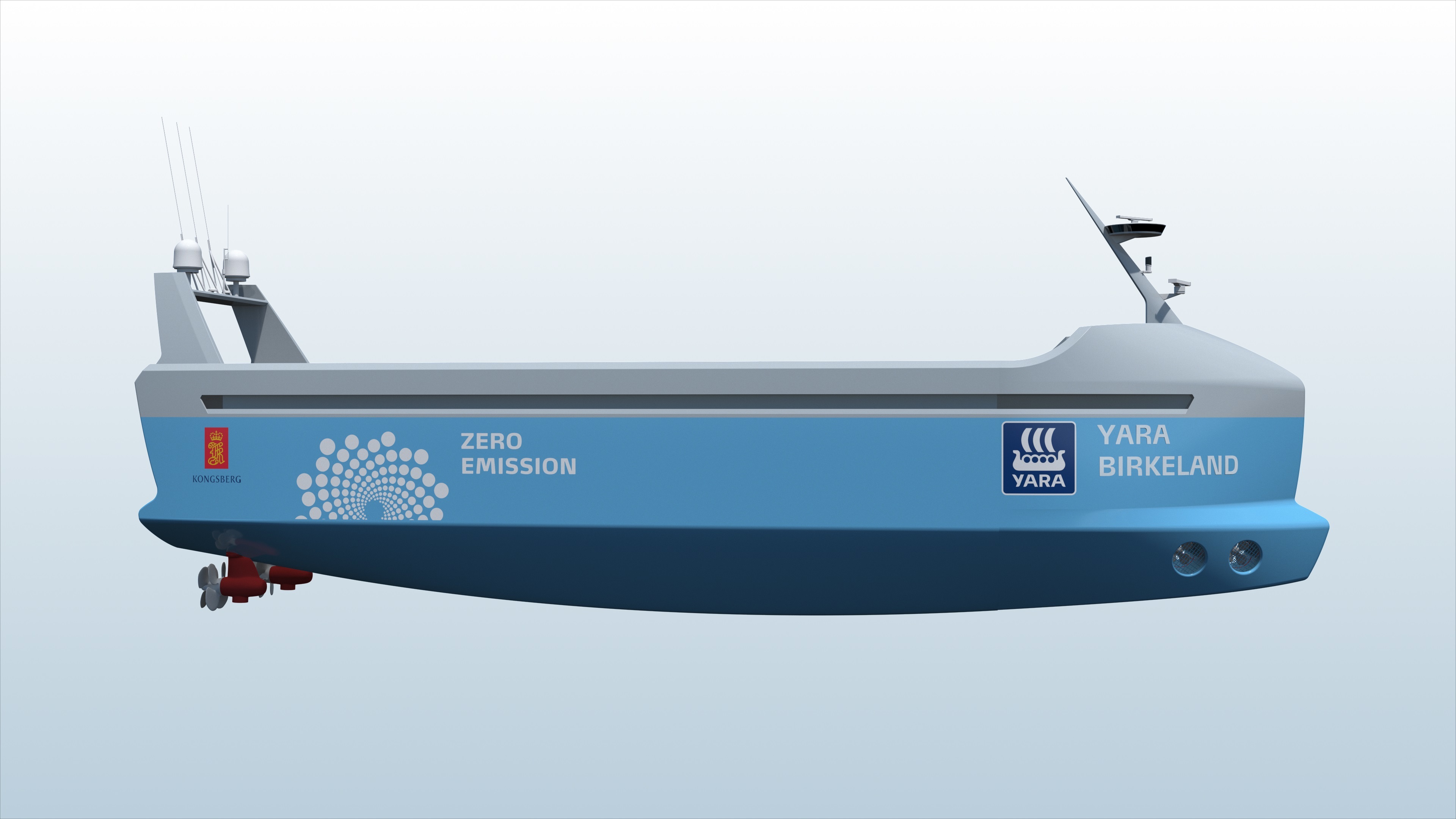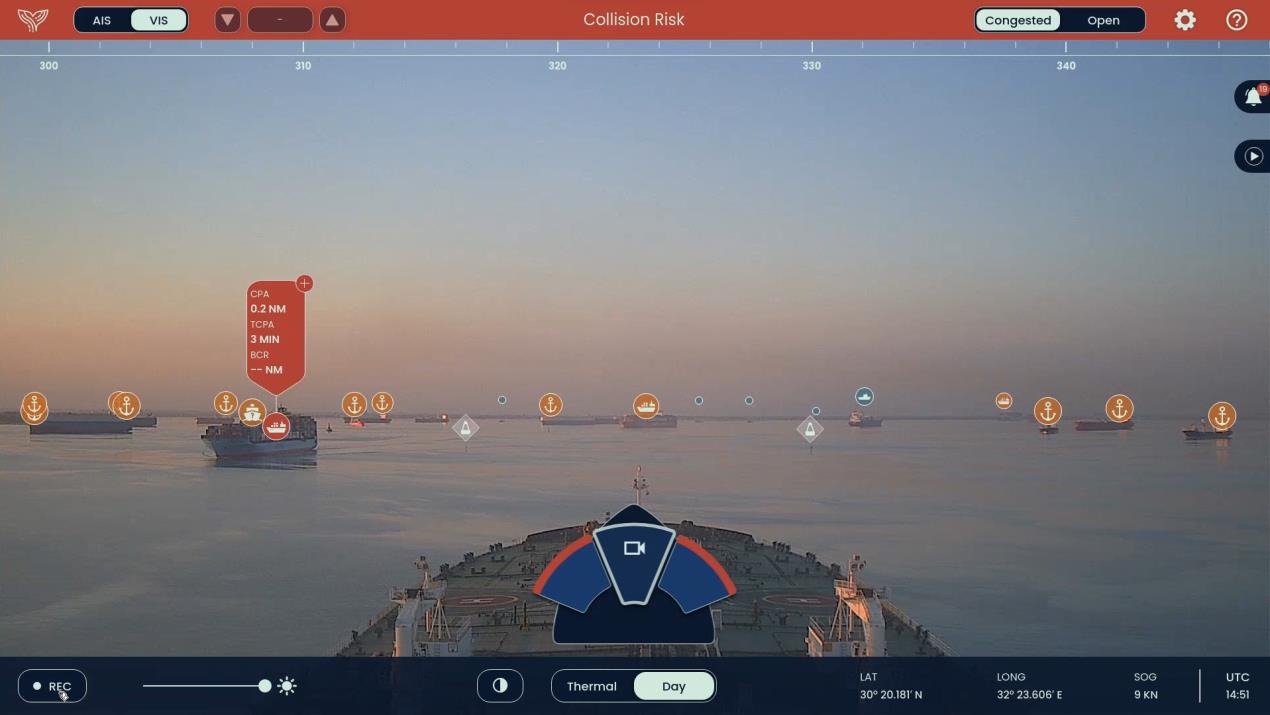TWO Norwegian companies, Yara and Kongsberg announced last month that they are set to make history with the first autonomous commercial vessel, a 100-150 teu feeder container ship.
Construction will be completed next year. Kongsberg has confirmed it will be built with a removable wheelhouse, with unmanned operations planned for 2019 and autonomous operations the following year.
It will be an battery powered, all electric vessel with autonomous moorings, no ballast and autonomous cargo operations. It will operate in Norwegian coastal waters in Southern Norway form one of the Yara production plants. The purpose of the vessel is to replace 40,000 containerised truck journeys made by road from Porsgrunn to Brevik, which is 7nm away by water, and Larvik, some 30nm away
While Yara sees an economic and environmental case for the vessel, it marks a significant step in Norway’s drive to find commercial uses for the vast experience in the country in digital, connected solutions, particularly in the maritime industry.
A two horse race?
But Norway is not alone. Another Nordic country, Finland has also been pushing a digital transport agenda, with a strong focus on maritime transport.
Both countries have technology clusters racing to be at the forefront of unmanned and autonomous ships. Two years ago the Finnish government even adapted its transport laws to allow testing of autonomous cars, trucks and ships.
Finnish efforts recently coalesced into a commercial collaboration called the One Sea Autonomous Maritime Ecosystem. This is being coordinated by a central cluster organisation called DIMECC, an organisation that is owned by 70 Finnish technology companies (from a range of industries) and has the purpose of promoting their digital agenda. DIMECC stands for Digital, Internet, Materials & Engineering Co-Creation.
The partners have said they want to see remote controlled vessels by 2020 and autonomous ships in the Baltic Sea by 2025. One of the partners suggested to Fathom-News that there will be something being announced soon, but would not give any details.
It is worth differentiating between autonomous and unmanned ships. The latter will likely be first and is very much where a vessel is remote controlled or has heavy oversight. Autonomous ships involve having the systems on board to make autonomous navigational decisions without a human operating it.
Both need sophisticated reliable and safe ecosystems to be in place.
The One Sea consortium notably lacks any shipowner members, being all system developers and suppliers and shipbuilders. The same is true somewhat of the Norwegian efforts, although Yara, as a cargo owner will be the owner of the Yara Birkeland. And that in itself may be a telling fact. It is a cargo owner taking ownership of the first unmanned vessel, not a traditional shipowner
The DIMMEC ONE SEA consortium says that “ship owners and operators should consider when to take advantage of the lower capital and operating expenditure – with the better efficiency, reliability, safety and sustainability –that digitalization has brought into other areas of business and industry.”
Hurdles
But to achieve their eight-year goal of creating an autonomous ship in international waters some key challenges have to be overcome, and the project aims to overcome them. Cyber security, reliability of systems and of course regulatory issues such as manning levels and not least insurance
Cefor, the Nordic association of Marine Insurers, stated in its end of year report:
“In addition to the regulatory and liability aspects, insurers also need to address the risks related to new technologies and the internet of things. Cyber-attacks, connectivity, complex technologies, and autonomy assisted accidents are among the challenges. Insurers will expect classification societies to become involved in the approval of big data and automated operational procedures in order for these to be insurable in the future”
Helle Hammer, managing director of Cefor, says there is a growing need for insurers to be aware of these developments. Speaking at one of the Nor-Shipping Disruptive Talk panels in Oslo last week she pointed to the hurdles that need to be overcome before insurers and regulators welcome either unmanned or even autonomous commercial ships.
But while companies like Kongsberg, Rolls-Royce and Wärtsilä are seen as the technology drivers of unmanned and autonomous ships, what they are mostly trying to promote is the integrated ship intelligence systems that they have on offer for companies wanting to build more sophisticated high end vessels, cruise ships, offshore vessels and LNG carriers.
Even Oskar Levander, the Rolls Royce expert based in Turku, Finland, and most closely associated with the evolution of vessel autonomy has said the latter two will not be the first vessels to be autonomous. Simple straightforward coastal vessels on basic A to B voyages will likely be the first (such as the Yara Birkeland). Some harbour or basic offshore workboats could also be amongst the first.
Some publicly available data on Yara BirkelandMain particulars LOA: >70 m Beam:15 m Depth: 12 m Draught (full): 5 m Draught (ballast): 3 m Service speed: 6 kn Max speed: 10 kn Capacity Cargo capacity: 100 - 150 TEU Deadweight: 3500 - 4500 mt Propulsion Electric propulsion 2 Azimuth pods 2 Tunnel thruster Battery pack: 3,5 – 4 MWh Key sensors Camera Radar AIS Lidar IR camera Loading /unloading:Loading and unloading will be done automatically using electric cranes and equipment. The ship will also be equipped with an automatic mooring system. Operational area: The vessel will sail within 12 nautical miles from the coast, between 3 ports in southern Norway. The whole area is completely covered the The Norwegian Coastal Administrations' VTS system at Brevik. The distances between the ports are:Herøya – Brevik (approx. 7 nm) Herøya – Larvik (approx. 30 nm) Operation/control centres: To ensure safety, three centres with different operational profile are planned to handle all aspects of operation. These centres will handle emergency and exception handling, condition monitoring, operational monitoring, decision support, surveillance of the ship and its surroundings and all other aspects of safety. YARA at Porsgrunn Kongsberg Maritime Kystverket VTS centre at Brevik - to be decided
Fathom-News
editor@fathom-mi.com

































